Introduction:
Processing speech in difficult listening environments to allow maximal word and sentence recognition is the single greatest challenge facing hearing aid researchers and manufacturers. Interference from background noise remains the greatest problem reported by hearing aid wearers a (Kochkin, 2002a, 2002b).
Over the past few years, advanced digital signal processing (DSP) hearing aids have implemented sophisticated compression, directional, noise management and feedback management systems. Although these management systems appear beneficial when used independently, well elucidated strategies regarding their interactions -- have typically gone unaddressed.
In essence, when two or more systems are operating simultaneously, the result is often unknown and indeed, potential negative interactions are possible. For example, if activation time of the noise management system is adjusted to be very quick, while compression or an adaptive directional system is set for a slower, more gradual response, unexpected corruption of the signal can occur. If compression, directional and noise management systems all independently apply signal reductions, the total effect can be an objectionable amount of loudness attenuation and audibility reduction for the patient. Hearing healthcare professionals have expressed increasing confusion regarding how to best manage patient concerns, when several systems are simultaneously operating.
Until now, hearing instruments have relied on comprehensive prediction models combined with sequential processing to select the preferred processing option (Gabriel, 2002; Kates, 1995). Because this method does not actually compare different outcomes, an incorrect solution can be selected due to the unpredictability of complex communication environments (Gabriel, 2002).
Therefore, the challenge has been to design a coordinated processing system to manage and select the best response of the various individual systems, such as compression, adaptive directionality or noise reduction.
Parallel processing, provides the significant advantage of not relying on predictive models but rather, parallel processing processes and compares each outcome for the best solution. In fact, parallel processing is a prerequisite for artificial intelligence that allows multiple processing schemes to be evaluated simultaneously to ensure that the best solution is implemented.
In this article, I will address the issues noted above, with specific regard to their application and solution, in the Oticon Syncro DSP circuit.
I. Overview of Oticon Syncro:
The Oticon Syncro is a multi-channel, nonlinear DSP hearing aid available in all shell configurations, from BTEs through CICs. Syncro implements wide dynamic range compression across eight channels with a maximal bandwidth of 7500 Hz. The compression model used in Syncro is based on "softness imperception" (see Buus & Florentine, 2001).
Syncro features include fully adaptive directionality, which is independently implemented in four frequency bands to allow distinct and independent polar responses across the four frequency regions. Directionality can be applied in some frequency regions, while maintaining omni-directional performance in others. The product has a novel noise management approach which combines two previously implemented noise management circuits; modulation analysis and synchrony analysis (Schum, 2003) to allow simultaneous application of comfort-based and speech-based goals. Syncro uses a phase-cancellation anti-feedback system that, when combined with the fast through-put time of the digital circuit, allows for the application of open ear fittings. This occlusion-reduction strategy has been demonstrated to be effective while maintaining the benefits of directionality. The compression, directionality and noise management system are implemented using true parallel processing, with an Artificial Intelligence-based coordination system called Voice Priority Processing (VPP). Using VPP, each system processes signals in parallel to determine the best combination of settings. The signal is constantly improved and progressively optimized.
Identity: A Unique Syncro Attribute
To address the issues (above) in the Oticon Syncro, we have introduced the concept of "Identity." An Identity is a discrete group of settings designed to operate efficiently and appropriately - when used together. Identities are prescribed based on a variety of demographic variables.
There are five Identities, which can be best thought of as a continuum:
- Calm
- Gradual
- Active
- Dynamic
- Energetic
An Identity is a discrete group of settings across a broad range of device dimensions, all designed to operate effectively together. The selected Identity will impact dimensions of device performance such as:
- speed of adaptation of polar plots
- speed of changing between directional modes
- threshold for changing between directional modes
- speed of application of gain reductions by the TriState noise management system
- amount of gain reduction in the Speech plus Noise mode
- frequency response
- compression attack & release time
- maximum possible compression ratio
Each identity was developed to manage the ever increasing complexity of DSP hearing instruments with true, simultaneous parallel processing of many systems. Identities were designed to simplify the fitting and follow-up process, leading to more efficient use of clinical time and increased patient satisfaction. Each Identity is a unique combination of a multitude of settings of many technical dimensions.
When fitting or adjusting Syncro, the professional selects one of five Identities. In general, when moving from Identities such as Calm and Gradual to Identities such as Dynamic and Energetic, the speed and amount of reaction to changes in the acoustical environment increases. Some patients prefer or may perform better with a more aggressive approach (such as Energetic) whereas others may be better off with a more subtle approach (such as Calm).
Multi-band Adaptive Directionality:
Some commercially available hearing aids implement automatic directionality, in which the hearing aid analyzes certain acoustical characteristics and selects between a preferred directional or omni-directional setting. Some products include an adaptive single-band polar response within the directional mode, whereby timing characteristics of the directional system are constantly updated so as to implement the polar response that best attenuates competing sound at that point in time.
Syncro includes automatic switching and adaptive polar responses. Uniquely, the Multi-band Adaptive Directionality (MAD) offers four independent adaptive directional systems, each active in a discreet frequency region. Importantly, the decision to automatically switch from omni to directional does not necessarily apply to all four frequency bands. Syncro offers a combination of omni and directional performance in three operational modes: Surround (omni), Full Directional and Split Directional. In the Split Directional mode, the low frequency band (below 1000 Hz.) is kept in omni and the three high frequency bands are in directional mode. A complex, interactive set of decision-making criteria to control the switching between modes controls the MAD. With parallel processing, we have gone beyond predictive approaches and have implemented a confirmation-based approach to control switching between directional modes to provide the best signal-to-noise (S/N) ratio. This analysis primarily is based on modulation characteristics of the output signal through each possible mode, but also includes constant and simultaneous analyses of the front-back ratio, presence and degree of wind noise and overall input level.
The MAD system allows for three important benefits:
- Suppression of Multiple Noise Sources:
- Multiple sources of noise competition can be attenuated. For example, if the dominant noise source in the low frequencies originates from one direction, while a second competing noise source in mid-or-high frequencies originates from another direction, Syncro can provide different, optimized polar response in the different frequency regions to maximally attenuate both noise sources simultaneously.
- Intelligent Selection of the Directional Mode:
- Selection of the operational directional mode is based on an evaluation of the output signal created by the three possible modes, as compared to typical predictions based on the input signal. Walden et al. (2004) noted a unique set of circumstances must be operational for patients to prefer their devices be in the directional mode. Unfortunately, it is not that directionality is always desired when the input signal is high or whenever speech is present. Rather, Walden et al. (2004) indicated that for directional to be preferred, speech must be present from the front and nearby and that noise must arise from a direction other than the front. Systems that base the decision to shift into directional exclusively on overall input level will select directional even if no speech is present, or if both speech and noise come from the front, or when speech is coming from behind. Even predictive systems that use a more complex set of criteria can often select an inappropriate setting (Gabriel, 2002). By using a confirmation rather than a predictive approach, and by basing the decision to employ Split or Full directionality on the best S/N, Syncro is more likely to select directionality -- when it is truly appropriate.
- Directionality in a Broader Range of Situations:
- The multi-band nature of the directional system, and the three possible operating modes allow directionality in a broader range of environments. In all directional systems, switching from omni to directional has potential advantages (such as improved S/N) and potential disadvantages (increased internal noise and reduced sound quality). Therefore, previous automatic switching systems tended to place the threshold between omni and directional at a relatively high level to avoid possible degradation in sound quality. Thus, in moderate sound environments in which the patient may have benefited from directionality, the system stayed in omni mode. In Syncro, while maintaining the low frequency directional band in omni mode, but placing the three high frequency bands in directional modes, the trade-off between performance and sound quality is avoided.
TriState Noise Management:
The primary challenges of noise management systems are to accurately identify and reduce background noise, while maintaining crucial speech information. Noise management systems measured certain characteristics of input signals and used gain reduction to improve listening comfort (Alcantara, Moore, Kuhnel, & Launer, 2003; Schum, 2003). Two approaches to noise management have been used; detection of speech via synchrony detection (Elberling, 2002), and evaluation of noise through modulation detection (Alcantara et al., 2003). Synchrony Detection provides wide-band binary decision making -- speech present or not - providing overall comfort-based gain reduction in louder conditions whenever speech is not present (Elberling, 2002). Modulation detection assesses the likelihood of relatively stable noise is specific frequency regions. This approach tends to be sensitive to the presences of any noise, whether speech is also present or not (Elberling, 2002; Flynn, 2003; Schum, 2003), and runs the risk of applying gain reduction to important speech information.
Syncro combines synchrony detection and modulation detection in the TriState Noise Management system, allowing the advantages of previous approaches, without the disadvantages, noted above. Syncro's TriState noise management system provides a comfort-based reaction to noise either:
(1) when speech is not present, in a broadband manner or
(2) when speech is present, in the non-essential frequencies while maintaining audibility in the essential frequency regions.
By using this combined approach, Syncro presents three different noise management modes:
- Speech in Quiet
- to ensure optimum speech understanding across a wide range of input levels.
- Noise only
- to provide maximum attenuation at all frequencies when only noise is present.
- Speech in Noise
- to adjust the degree of frequency specific noise reduction, in accordance with the Articulation Index (AI) to ensure speech understanding is maintained.
Open Ear Acoustics: Issues in Occlusion, Feedback Management, Directionality and Ski-Slope Hearing Loss
Occlusion is a major reason new hearing aid wearers reject amplification. The most effective and direct solution to occlusion is a large vent in the hearing aid shell or earmold. Of course, large vents allow acoustic feedback as sound "leaks" from the receiver to the microphone through the vent, and therefore, venting must be accompanied with effective feedback cancellation.
Acoustic feedback cancellation algorithms in DSP hearing aids allow the possibility of non-occluding (large vent) fittings. However, technical challenges related to timing (the interaction of direct sound through the open vent with the delayed, digitally processed sound) have prevented open ear (large vent) fittings from being offered across the industry.
Oticon has created a technical solution which allows most fittings to utilize large venting to eliminate occlusion, while providing patients with a more natural sound and a more acceptable hearing aid experience. Syncro (and selected other digital products from Oticon) are the only products on the market that offer open ear acoustics for patients across the fitting range without imposing limitations on the channel structure and flexibility of the product.
It is essential that reduced occlusion does not come at the cost of other device benefits: most importantly -- directionality. The design of the directional system in Syncro is such that Open Ear Acoustics co-exists with maximized directionality in the mid and high frequencies. Patients have achieved excellent directional benefit with Syncro even in the presence of open ear venting (see below).
Ski-slope Hearing Loss:
In 1998, Oticon introduced a specific fitting rationale ("Ski") in the DigiFocus product line designed for patients with ski-slope hearing loss. The Ski rationale was verified via independent clinical testing (Gabriel & Kollmeier, 1999) and was carried forward through Oticon's Adapto product line. The Ski approach was further enhanced through the availability of true feedback cancellation and open ear fittings in Adapto and has been carried forward in Syncro. This approach to ski-slope hearing loss has proven to be beneficial and allows enhanced audibility for important speech cues in the mid-to-high frequencies and helps assure better sound quality and comfort for patients with ski-slope hearing losses. The provision of a ski-slope correction in gain and compression characteristics is automatically applied by the fitting software.
II. Outcomes:
Overview of Verification Studies:
Based on design principles and the integrated functionality described above, the key question remains.....Does Syncro meet the challenges outlined in the Introduction (above)? Specifically, does Syncro manage and select the best response from the various individual systems (compression, adaptive directionality, noise reduction) to provide a maximal speech signal in quiet, noise and other challenging situations?
This section summarizes two important on-going verification studies.
A. Patient Based Internal Verification:
Flynn & Luuner (2004) performed an internal verification study at Oticon in Copenhagen, Denmark. Their study included experienced hearing aid users with moderate sloping sensorineural hearing loss. Data from those 37 patients is cited here. All subjects (mean age = 67 years) were satisfied and current users of advanced ITE/ITC non-linear, digital hearing instruments from a variety of manufacturers.
Subjective performance was measured comparing the patients' previous, well-fit advanced technology hearing aids to Syncro custom fittings. Objective speech understanding in noise was measured comparing Syncro to Adapto reference fittings made on each patient.
Regarding subjective reactions, two approaches were used. Patients provided subjective ratings of performance across nine dimensions for Syncro and for their own devices. Secondly, patients provided "head-to-head" preferences across 21 specific listening and use situations.
Figure 1 (below) provides mean subjective ratings for 37 patients across nine listening situations. Statistically significant differences between mean ratings for Syncro compared to the patients' own devices are highlighted in red. As can be seen, these differences occur for some of the most challenging communication environments faced by patients: (see "speech in a group" and "speech along the street").
Figure 1: Mean subjective ratings comparing Syncro to the subjects own digital devices (from Flynn & Lunner, 2004). Statistically significant (p<.05 differences are highlighted.>
Figure 2 (below) provides results from "head-to-head" preferences. Note, as in the above, strongest preferences for Syncro tended to be found in the most challenging listening situations (speech in the street, speech at a distance, speech in a car, party & restaurant situations, etc.).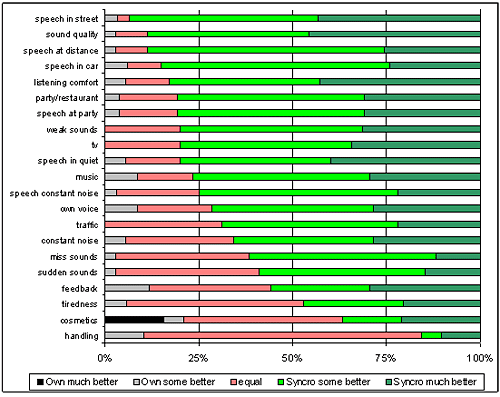
Figure 2: Head-to-head comparison of Syncro to the subjects own digital devices (from Flynn & Lunner, 2004).
Flynn & Lunner (2004) also measured speech understanding in noise using a Danish adaptive speech in noise test (Dantale II). They compared performance with Adapto in omni and directional modes to performance with Syncro in Surround (omni), Split-Directional and Full-Directional. Results are presented in Figure 3 (below). When comparing mean performance with both devices in omni-directional modes a nearly a 2 dB improvement in performance was determined in favor of Syncro, and each 1dB in SNR equals an approximate increase in speech understanding of 10% (Dillon, 2001).
Figure 3: Mean SNR results comparing performance with Adapto to Syncro
Flynn & Lunner (2004) also collected subjective ratings on the two devices across three domains on the Hearing Aid Performance Questionnaire: Comfort, Speech Understanding and Overall Performance, and their results were specified in terms of the prescribed Identity per patient. Recall that based on demographic factors, such as age and hearing aid experience, patients were prescribed an Identity to manage some device characteristics. Figure 4 (below) provides subjective ratings for three prescribed Identities. For all three domains and for all three subject groups, the mean ratings were higher for Syncro than with Adapto. All mean comparisons reached statistical significance (p<.05>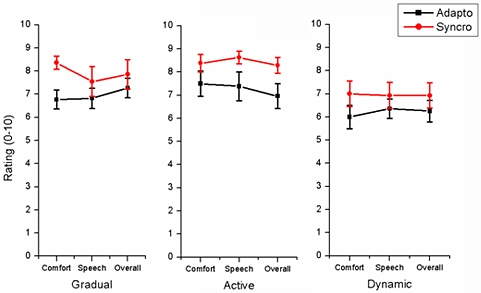
Figure 4: Mean subjective ratings on the Hearing Aid Performance Questionnaire results comparing performance with Adapto to Syncro.
B. Patient Based External Verification:
The second study (Flynn, Pogash & Schum, 2005) was an external verification, and involved data gathered from seven countries (U.S.A., U.K., Germany, Canada, Australia, New Zealand, France and Italy). The second study focused on initial subjective reactions from patients and professionals, to Syncro. Patients continue to be tracked across the seven countries.
Data is presented 302 patients, with 119 of those patients being new users and 183 being experienced. Over 50% of the presented patient data is from 28 different clinics in the U.S.A.
Figure 5 (below) provides subjective responses from 183 experienced patients. These patients were previously fit with various DSP devices, fit in the last four years, prior to being fit with Syncro. Patients were asked to compare the performance of Syncro to their previous hearing aids on a five point scale. On most questions, over 75% of the patients rated Syncro as "somewhat better" or "much better" than their previous devices. Ninety percent of the patients expressed an overall preference for Syncro. As with the Flynn & Lunner (2004) study, some of the strongest preferences for Syncro were in the most challenging listening environments (eg., speech in noise, changing levels of noise etc.).
Figure 5: Comparison of Syncro to Own Hearing Aid for 183 experienced hearing aids users from 8 countries.
Data for new users was also collected, using the same parameters. However, instead of "comparison to previous hearing aids," the ratings were made on a 1 to 5 scale, where 1 indicated "poor" performance, through 5, which indicated "excellent" performance.
Figure 6 (below) provides data from 119 new users. The majority of scores obtained from the new users ranged from neutral through excellent range, as 50 to 75% of the ratings were a "4" or "5" on most items.
In general, it is assumed new users compare performance of their new hearing aids to their memory of normal unaided hearing, or to their expectations of what amplification should provide. Surprisingly, despite the well documented trend for new hearing aid users to have excessively high expectations (Schum, 1999), ratings on their initial fittings with Syncro were generally positive.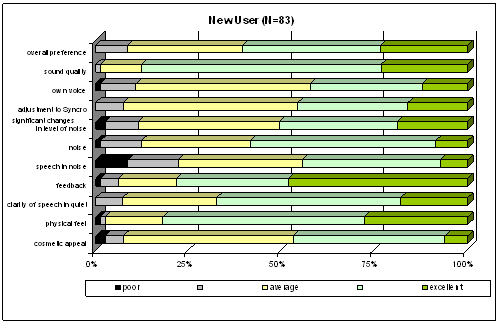
Figure 6: Subjective ratings of Syncro by 119 new hearing aids users from 8 countries.
C. Professional Based External Verification:
We collected responses from 121 fitting professionals worldwide. All professionals had at least 10 patients they had fit with Syncro. Professionals were asked to rate their experience with the Syncro product and fitting software, as compared to their experience with other advanced technology products. A five-point scale was used, ranging from 1 = poor, to 5 = excellent.
Figure 7 (below) summarizes the data collected from 121 professionals.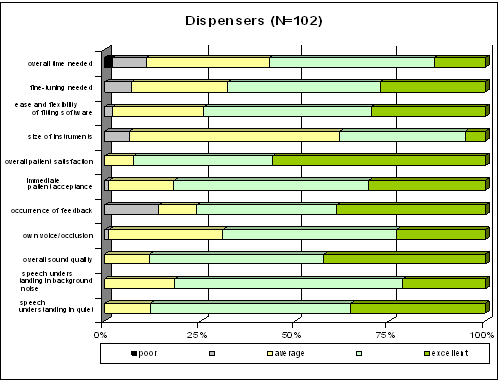
Figure 7: Ratings of Syncro and the Genie fitting software by 121 experienced clinicians from 5 countries. Note, the very low occurrence of negative ratings. Ratings of "4" or "5" occurred over 75% of the time, on the majority of measures. Additionally, there was a high rate of positive ratings on important dimensions such as overall patient satisfaction, immediate patient acceptance and speech understanding in background noise.
III. Discussion
Evidence in Support of Unique Technical Features:
Within the general results from these two studies as background, we will now examine specific evidence in support of the unique features of Syncro, as outlined above.
1. Suppression of Multiple Noise Sources: Many challenging listening situations are those with a variety of noise sources. The unique, multi-band design of Syncro allows multiple noise sources to be independently suppressed, if they are distinct in spatial orientation and in predominant frequency content. Figure 8 (below) provides an example. In this case, a Syncro BTE was placed in the soundfield with two different noise sources presented simultaneously. The upper panel provides the spectra of the two real-world competitions: a kitchen mixer presented from 90 degrees azimuth and a washing machine presented from 180 degrees azimuth. Notice the predominant mid-frequency peak from the mixer and the low-frequency weighting of the washing machine. In the lower panel, the output of Syncro was recorded. The upper, green line is the output when the instrument was forced to remain in omni-directional mode. The influence of both the mid-frequency mixer and low frequency washing machine is evident. The middle, red line shows the response when the device is forced into an adaptive, single-band mode (a mode that is not available in the commercial instrument, but is technically possible in the device and mimics single-band adaptive directional systems on the market). In this case, due to the higher overall level of the mid-frequency mixer, the adaptive directional system chose a polar plot that effectively reduced this peak, but had only a modest effect on the low frequency washing machine. The lower, blue line represents the response of the device when allowed to operate in the fully adaptive, four-band mode. In this case, the mid-frequency peak is suppressed as in the single-band mode, but also there is significantly greater reduction applied to the low-frequency washing machine arising from another direction. This example demonstrates the ability of independent bands to locate and suppress multiple competitors simultaneously.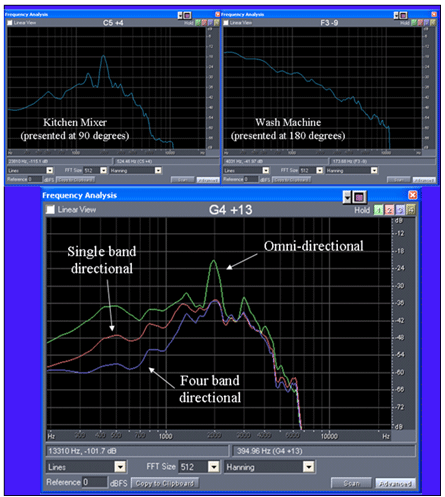
Figure 8: Upper panel: spectra of two sound sources presented to Syncro from two different angles. Lower panel: output of Syncro when in omni, single-band and four-band directional.
2: Device Decision Making: The distinctive characteristic of the directional system in Syncro is the use of parallel processing to simultaneously evaluate three different directional modes, to yield the maximal S/N ratio. To test this hypothesis, Syncro was compared to another advanced technology digital hearing aid with fully adaptive directionality. Thus, the comparison product used a set of input variables (input level, modulation, spectral characteristics) to select omni versus directional operation. In addition, the comparison product offered different biases in the operation of the directional system, including an emphasis on comfort versus an emphasis on audibility. However, despite these relatively sophisticated functions, the core decision making within the directional system of the comparison product was predictive.
These two devices were evaluated in the soundfield by presenting various combinations of speech and noise signals from various orientations to evaluate decision making processes in the two devices. Syncro was tested in the Active Identity. The comparison product was tested in the Comfort Mode and the Audibility Mode.
Table 1 (below) provides the decision making results for six different test conditions.
Based on general logic and the results from Walden et al. (2004), it would seem that directionality would be appropriate in conditions 3 and 4, where speech was present from the front and noise originated from behind. In the remaining conditions, directionality would neither be needed (1) nor effective (2, 5 & 6). As pointed out by Walden et al. (2004), if directionality is not effective at improving the S/N, patients seem to prefer an omni-directional setting. Note the Syncro device chose Split Directionality in condition 3 and Full Directionality in condition 4. In all other conditions, the device remained in omni-directionality. The likely reason Split was chosen for condition 3 while Full was chosen for condition 4 has to do with signal levels. At moderate signal levels, Syncro chooses Split Directionality to provide the benefits of directionality in the mid and high frequencies but the sound quality benefits of omni-directionality in the lows. With a greater noise level in condition 4 compared to condition 3, the overall level was higher and thus led to the change to Full Directionality mode.
The comparison product made no distinction between any of the signal conditions. Despite the relatively complex set of input variables considered, it's decision as to directional mode seems to be totally dependent on the bias setting between Comfort or Audibility: directionality was always used in the Comfort setting and never used in the Audibility setting.
3: User Experiences with Directionality: Figure 3 (above) provided the objective performance in noise across the directional modes compared to Adapto (which incorporates single-band, fixed directionality). Speech understanding was calculated in terms of the speech reception threshold (SRT) in noise for the reference hearing aid (Adapto) and Oticon Syncro in prescribed settings. Analysis of Variance indicated that in each condition, Oticon Syncro provided significantly better speech understanding than the reference hearing aid (p<.00001 this performance increase was in the region of s for omni-directional mode increasing to almost when full-directionality enabled. as noted earlier each snr equals an approximate speech understanding>
Regarding subjective effects, it is difficult to tease out the effects of directionality from more general systems such as the TriState Noise Management system and the Voice Aligned Compression. However, it is widely recognized that the only system in modern hearing aids that directly improves the S/N is directionality. Therefore, when reviewing subjective results from both the internal and external verification studies (noted above) the results speak directly to the perceived improved performance in noise. The assumption is that the major influence on this perceived improvement in speech understanding is the directional system.
4: Speech-based Noise Management: Previously, when manufacturers implemented noise management programs, they had to choose between modulation analysis or synchrony analysis. Syncro combines both approaches. In the presence of a speech plus noise, gain reductions will be applied to the lows and the extreme high frequencies to provide some level of comfort improvement, while protecting important mid to high frequency speech information. When speech is no longer present, further gain reductions will be applied across the bandwidth of the device.
Notice in Figure 2 (above) when comparing previous advanced technology hearing aids, Syncro was given strong positive ratings both on dimension dealing with speech understanding in noise, and also listening comfort.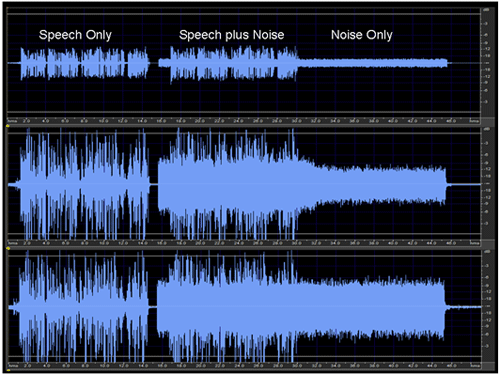
Figure 9: Waveforms of Speech, Speech plus Noise and Noise only. The top panel is the input signal, the middle panel is the output of Syncro with the TriState Noise Management system activated and the lower panel is the output with TriState system de-activated.
Figure 9 provides waveforms of speech and noise signals as processed by Syncro to demonstrate this effect. The input signal is shown in the upper panel, starting first with clean speech, followed by speech plus noise with a +5 dB S/N, and ending with noise only. The middle panel shows the output with the TriState system enabled. The lower panel shows the output of a Syncro BTE on KEMAR with the TriState Noise Management system disabled. (In all conditions, the directional system disabled to insure that the observable effects were not being modified by the action of the MAD system.)
Figure 10 (below) provides spectra of the two output signals during the three indicated time periods: speech only, speech plus noise and noise only. The area in red represents the response of the aid when the noise reduction system was disabled. The blue area represents the response when the noise reduction was active. The effect of the TriState Noise system is clear by comparing the response in red versus the response in blue. When speech is present in a background of noise (middle panel), the gain reductions are applied in the non-essential speech regions (in this example, below 800 Hz. and above 4000 Hz.) When the signal is noise only (right panel), the reductions are comfort-based and are applied across the bandwidth of the hearing aid.
Figure 10: Spectra of portions of the waveforms from Figure 9 while TriState was active (blue area) and de-activated (red area).
5: Identities: The Value of Individualization: During the fitting of Syncro, one of the three middle Identities was prescribed to each of the patients based on a variety of demographic issues, as previously indicated. Of the 37 patients in the internal verification study, 33 completed further testing specifically designed to examine preferences for various Identity options.
The 33 participants were distributed across the three possible prescribed Identities: 11 were prescribed Dynamic, 14 were prescribed Active, and 8 were prescribed Gradual.
To determine accuracy of the Syncro Identity prescriptions, patients were allowed to adapt to their original prescribed identity. After that, they were given 2-3 weeks to use the first alternative Identity, and then another 2-3 week period was used to listen to the second alternative Identity. Following exposure and experience with all three alternative Identities, they were asked to indicate their preferred Identity.
Figure 11 provides the results of this analysis. As can be seen, 25 of the 33 patients (76%) preferred the original prescribed Identity. Four patients (12%) preferred one of the more stable alternatives and four patients (12%) preferred more aggressive options.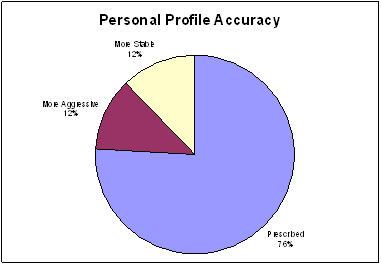
Figure 11: Percentage of the patients in the internal verification study who preferred the prescribed Identity, a more aggressive option or a more stable option.
These data indicate three important aspects of the prescription of Identities:
First, patients can distinguish between Identities. The data from these subjects (and reports from clinicians across the U.S.A.) indicate that 75 to 80% of patients can clearly hear differences between neighboring Identities and a change of two steps is clearly audible to all patients. Second, the criteria we use to select the prescribed Identity appears to be accurate the majority of the time. When given two other options, patients chose the prescribed option 76% of the time. Finally, a significant minority of patients chose an alternative Identity which was evenly distributed between more stable or more aggressive alternatives, which justifies the need to be able to customize the product.
To examine the selection behavior for Identities more closely, a second phase of listening test were performed. In this phase, patients compared their prescribed Identity to the option on either side of the prescribed, even if it was not one of the normally available prescribed Identities. In other words, all five Identities were available to the patients. Figure 12 provides the distribution of results.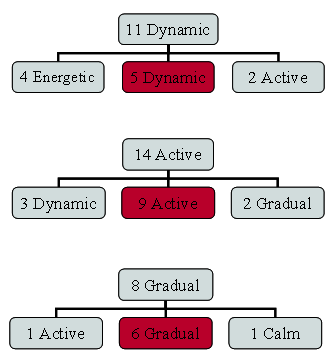
Figure 12: The distribution of patients in the second phase of the Identity evaluation who selected either the prescribed Identity or one of the two neighboring options.
Twenty of the 33 participants (61%) chose the prescribed Identity. Across the three prescribed starting Identities, there is an approximately even distribution for those choosing more stable option or more aggressive options. Once again, the general accuracy of the prescription process is supported, but the need to be able to quickly and efficiently offer alternatives is also indicated
Interestingly, when patients were probed as to their reason for the selection of one Identity over the other, there were some interesting responses. The first column in Table 2 includes the responses from the patients choosing between two of the more aggressive Identities, Energetic vs. Dynamic. The second column includes statements by patients choosing between two of the more stable alternatives, Active and Gradual.
Although these comparisons represent quite different Identities, the reasons for preference seem to be along similar dimensions (i.e., speech understanding, sound quality & comfort concerns). Although the nature of the hearing loss and the listening needs of the patients varies considerably, the issues on which they judge the performance of hearings aids are similar. These responses confirm the need to be able to easily offer alternatives.
6: Open Ear Acoustics & Directionality: A core aspect of the Open Ear Acoustics concept is provision of a large vent to minimize the occlusion effect. Collection vents are larger at the medial (ear canal) end than at the distal (faceplate) end. Went sizes typically reflect the faceplate opening. Ear canal size is typically 4 to 5 mm or larger. The effect of a collection vent is to increase the effective vent by approximately .5 to 1 mm, and a 2.5 mm collection vent will have the venting effect of a 3.5 mm straight vent. Previously, we have documented the technical reality of occlusion reduction with open ear acoustics (Williams & Wynne, 2003).
Subjectively, results from the external verification study, especially those from the experienced users, provided evidence of the effectiveness of this concept. Notice on Figures 2 and 5 (above) the observations of experienced users of advanced technology products, the strong positive ratings on the dimensions of own voice, feedback and physical feel. Improvements were reported on these three dimensions for 60 to 70% of the subjects.
Further, is important that the benefits of open ear acoustics do not compromise device performance -- specifically directionality. This issue was examined in the internal verification study. Figure 3 (above) reflects the directional performance of Syncro in the Split Directional and Full Directional modes. All patients were fit with custom products (ITCs and Low Profiles) with open ear vents. The average vent size was 2.2 mm, all constructed as collection vents. Despite the presence of these vents, there was a significant directional effect when moving from omni directional to Split Directional.
The greater than 2 dB improvement in S/N in Split Directional appears to reflect and confirm that the mid to high frequencies can effectively maintain directionality. Since the effect of an open vent is primarily confined to 1000 Hz. and below, it is not surprising that such a significant directional effect can occur even in the presence of open ear venting.
In addition, there continues to be a further, although smaller, S/N improvement when moving from Split to Full Directional. This reflects that, although an open vent will reduce gain in low frequencies, the effect is not total.
Since the initial internal verification was conducted with only custom products, this study was recently extended to include data from 11 addition patients who all were using BTE instruments. Because of the nature of BTE fittings, the venting can be increased. For this extension group, they were using, on average 3.9 mm vents in their earmolds. Figure 13 (below) provides a comparison between omni and Full Directional for this combined set of custom and BTE users.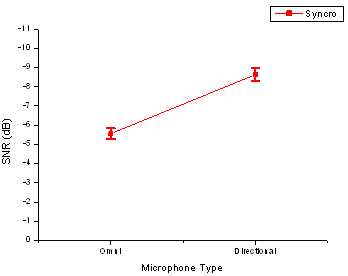
Figure 13: Average adaptive speech in noise thresholds for patients using Syncro in the Omni and Full-directional setting, with all patients fit with open ear vents.
The S/N improvement when comparing omni to Full Directional, even when including the BTE users with larger vents, is in excess of 3 dB. Statistical results indicated that this difference was highly significant (p<.00001 follow-up statistical analysis indicated no significant effects of hearing aid style indicating that the directional benefit was consistent across syncro models. additionally there a non-significant correlation between vent size and benefit. again concept open ear acoustics is demonstrated to be with use directionality.>
7: Software Correction for Ski-slope Hearing Loss: As indicated above, we have extended the concept of a specific correction for ski-slope hearing loss in Syncro. This correction is automatic and based on a test of the audiogram entered through Noah. Specifically, the average loss in the low frequencies is compared to the average hearing loss in the high frequencies. If the difference is great enough, the loss is classified as a ski slope hearing loss and a specific gain correction is applied. The rationale behind the gain drop in the presence of a ski-slope loss is that the patient can typically make better use of low and mid-frequency hearing as opposed to making use of remaining speech cues in the extreme high frequencies, where hearing is often so compromised that improved audibility is often of limited use (Ching et al., 1998).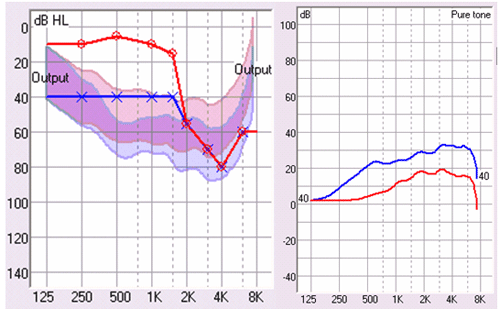
Figure 14: Left panel: audiogram of two different ears with the same amount of hearing loss in the high frequencies but different losses in the low frequencies. Right panel: prescribed insertion gain of Syncro for these two losses.
Figure 14 provides the estimated insertion gain provided by the Genie software for two hearing losses. Both hearing losses are identical in the region from 2000 through 8000 Hz. However, in the low frequencies, the hearing in the right ear is normal, whereas there is a mild-to-moderate hearing loss in the left ear. Notice the prescribed insertion gain in the high frequencies (where the hearing loss is identical) is at least 10 dB less in the right ear, where a ski-slope loss is present. Additionally, the drop in prescribed high frequency gain allows for a larger prescribed vent in the presence of ski-slope loss. In this example a prescribed vent of 3.0 mm was used in the right ear, versus 1.4 mm in the left ear. The larger vent size likely increased the opportunity for immediate patient acceptance, without compromising the effectiveness of directionality.
IV. Conclusions
Syncro was specifically designed to actively address the most common complaints of hearing aid users -- speech communication in difficult listening environments. The implementation of the Voice Priority Processing approach via a true parallel processing architecture was targeted to these difficult acoustic environments. Although speech understanding in noise was an overriding goal, issues such as sound quality, user comfort, the need for individuality and clinical efficiency were also considered.
The results of the internal and external verification studies speak to the success of that design process.
Specifically, we believe that Syncro can offer the following key benefits for patients:
- A multi-band directional system which attacks multiple sources of noise simultaneously and provides excellent performance in noisy situations along with the sound quality advantages of omni-directional.
- A noise management strategy that uniquely includes a speech recognition element to offer comfort-based gain reductions, while protecting the speech information available in the environment.
- Excellent speech understanding in a wide range of particularly difficult listening environments, with high ratings on the dimensions of sound quality and comfort.
- Simultaneous reduction of occlusion and protection of the directional effect.
- A unique, sound quality focused treatment for ski-slope hearing loss.
- A reliable device with an efficient Identity-driven fitting process that leads to high levels of immediate patient acceptance and low levels of follow-up and device returns.
References:
Alcantara, J. I., Moore, A. P., Kuhnel, V., & Launer, S. (2003). Evaluation of a noise reduction system in a commercial digital hearing aid. International Journal of Audiology, 42, 34-42.
Buus, S., & Florentine, M. (2001). Growth of loudness in listeners with cochlear hearing losses: recruitment reconsidered. Journal of the Association for Research in Otolaryngology, 3, 120-139.
Ching, T., Dillon, H. & Byrne, D. (1998). Speech recognition of hearing-impaired listeners: Predictions from audibility and the limited role of high-frequency amplification. Journal of the Acoustical Society of America, 103: 1128-1140.
Elberling, C. (2002). About the VoiceFinder. News From Oticon: Audiological Research Documentation, 3, 1-11.
Flynn, M. C. (2003). Maximizing speech understanding and listening comfort in noise. The Hearing Review, 7, 50-53.
Flynn, M.C., Lunner, T. (2004) Clinical evidence of the benefits of Oticon Syncro. News fro Oticon, November.
Flynn, M.C., Pogash, R. & Schum, D. (2004). International clinical verification of Oticon Syncro. News from Oticon, In preparation.
Gabriel, B. (2002). Study measures user benefit of two modern hearing aid features. The Hearing Journal, 55(5), 46-50.
Gabriel, B., Kollmeier, B., (1999). Test results on a new approach for fitting "ski-slope" hearing losses. The Hearing Journal, Vol. 52, No.6.
Kates, J. M. (1995). Classification of background noises for hearing aid applications. Journal of the Acoustical Society of America, 97, 461-470.
Kochkin, S. (2002a). MarkeTrak VI: 10-year customer satisfaction trends in the US hearing instrument market. The Hearing Review, 9(10), 14-25,46.
Kochkin, S. (2002b). MarkeTrak VI: Consumers rate improvements sought in hearing instruments. The Hearing Review, 9(11), 18-22.
Schum, D. (1999). Perceived hearing aid benefit in relation to perceived needs. Journal of the American Academy of Audiology, 10: 40-45.
Schum, D. (2003). Noise-reduction circuitry in hearing aids: (2) Goals and current strategies. The Hearing Journal, 56(6), 32-41.
Schum, D. J. (2004). Artificial Intelligence: The new advanced technology in hearing aids. Retrieved 14-06-2004, 2004
Schum, D. J., & Pogash, R. R. (2003). Blinded comparison of three levels of hearing aid technologies. Hearing Review, 10(1), 40-43, 64-65.
Walden, B., Surr, R., Cord, M. & Drylund, O. Predicting hearing aid microphone preference in everyday listening. Journal of the American Academy of Audiology, 15: 353-364.
Williams, C. & Wynne, M. (2003). Occlusion Reduction Through Vent Variation . Paper presented at the Annual Convention of the American Academy of Audiology, April, San Antonio, Texas.


